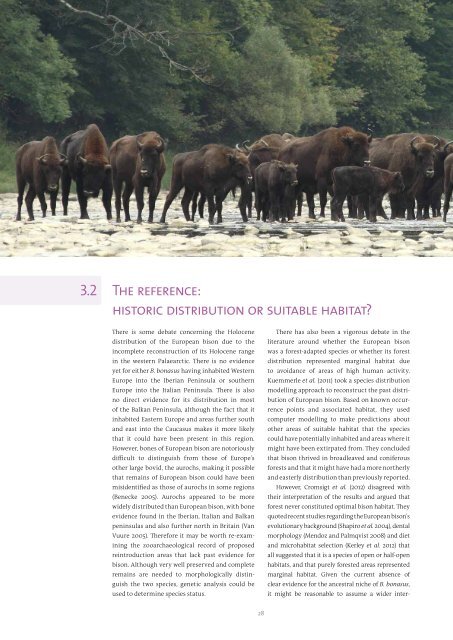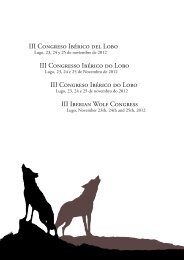Bison-Rewilding-Plan-2014
Bison-Rewilding-Plan-2014
Bison-Rewilding-Plan-2014
- No tags were found...
You also want an ePaper? Increase the reach of your titles
YUMPU automatically turns print PDFs into web optimized ePapers that Google loves.
3.2The reference:historic distribution or suitable habitat?There is some debate concerning the Holocenedistribution of the European bison due to theincomplete reconstruction of its Holocene rangein the western Palaearctic. There is no evidenceyet for either B. bonasus having inhabited WesternEurope into the Iberian Peninsula or southernEurope into the Italian Peninsula. There is alsono direct evidence for its distribution in mostof the Balkan Peninsula, although the fact that itinhabited Eastern Europe and areas further southand east into the Caucasus makes it more likelythat it could have been present in this region.However, bones of European bison are notoriouslydifficult to distinguish from those of Europe’sother large bovid, the aurochs, making it possiblethat remains of European bison could have beenmisidentified as those of aurochs in some regions(Benecke 2005). Aurochs appeared to be morewidely distributed than European bison, with boneevidence found in the Iberian, Italian and Balkanpeninsulas and also further north in Britain (VanVuure 2005). Therefore it may be worth re-examiningthe zooarchaeological record of proposedreintroduction areas that lack past evidence forbison. Although very well preserved and completeremains are needed to morphologically distinguishthe two species, genetic analysis could beused to determine species status.There has also been a vigorous debate in theliterature around whether the European bisonwas a forest-adapted species or whether its forestdistribution represented marginal habitat dueto avoidance of areas of high human activity.Kuemmerle et al. (2011) took a species distributionmodelling approach to reconstruct the past distributionof European bison. Based on known occurrencepoints and associated habitat, they usedcomputer modelling to make predictions aboutother areas of suitable habitat that the speciescould have potentially inhabited and areas where itmight have been extirpated from. They concludedthat bison thrived in broadleaved and coniferousforests and that it might have had a more northerlyand easterly distribution than previously reported.However, Cromsigt et al. (2012) disagreed withtheir interpretation of the results and argued thatforest never constituted optimal bison habitat. Theyquoted recent studies regarding the European bison’sevolutionary background (Shapiro et al. 2004), dentalmorphology (Mendoz and Palmqvist 2008) and dietand microhabitat selection (Kerley et al. 2012) thatall suggested that it is a species of open or half-openhabitats, and that purely forested areas representedmarginal habitat. Given the current absence ofclear evidence for the ancestral niche of B. bonasus,it might be reasonable to assume a wider inter-28



